Optoma UHD50X
Product Name: Optoma UHD50X
Product Description: 4K DLP Projector
-
Design - 9/10
9/10
-
Video Quality - 8.8/10
8.8/10
-
Ports & Connectivity - 9.2/10
9.2/10
-
OS, Apps and Features - 8.5/10
8.5/10
-
Price / Quality - 9.3/10
9.3/10
Summary
Total Score
Pros
- Extremely sharp 4K images
- Very good out of the box colors
- Low input lag
- Excellent price for 4K
Cons
- HDR performance could be better
- 240Hz refresh rate is limited to 1080p
- Mediocre black levels
- Pixel shifting is turned off with Game mode
Cheapest Places to Buy :
*We are a reader-supported website. When you buy through links on our site, we may earn a small affiliate commission at no extra cost to you. Home Media Entertainment does not accept money for reviews.*
The last few years we have seen projector manufacturers having made great progress with their 4K offerings either them being native 4K units or using pixel shifting for the cheaper models. But if there is one area that projector manufacturers seem to have neglected is at offering lower input lag that would make them ideal for gaming. Surely there have been a few gaming projectors here and there but these were very few and there is not such a big variety to choose from. Optoma seems took notice and in our Optoma UHD50X review we will be looking at a projector that is meant to change all that.

Now a gaming projector is not something new. We have seen a few of these models that offer input lag low enough to make gaming a much better experience. But with the arrival of 4K along with the imminent new gaming consoles the need for more projectors that can support the next generation of gaming is higher than ever. Optoma with their UHD50X claims to have the first projector with a 240Hz refresh rate. Higher refresh rate usually means lower input lag and more smooth motion. But things are not as simple as they may seem.
The Optoma UHD50X is in essence a 4K pixel shifting projector using DLP technology and with its high refresh rate promises to offer not only a good home theater experience but also provide the means for trouble free gaming sessions also. We have seen a lot of these sub-$2,000 projectors giving very respectable image quality results but most of them usually failed at providing input lags low enough for the most hardcore gamers to even consider them. And this is where the UHD50X comes in as its purpose is to be a good all around projector either you want it for home theater use or for gaming.
But with such a low price does the Optoma UHD50X manages to be a good all around unit or it tried to bite off more than it can chew? Let’s find out…
Design
Before we start we should mention that the UHD50X comes with different names on different markets. So while in the US this comes with the UHD50X naming in Europe along with other markets it can be found as the UHD42. We have seen this with many projectors and it’s still as puzzling as ever why manufacturers do that, that only adds to confusion. But anyway the UHD42 is exactly the same model with different name in case you were wondering.
As for its design don’t expect anything fancy here, after all we are at the bottom end of the price ladder so we tend to get the basics as far as overall looks is concerned. The UHD50X comes in a white boxy design with rounded corners and its looks are unique among the other Optoma projectors as only the lower UHD30 is using a similar shell. As for its size, measuring 12.4” x 4.6” x 10.6” (315 x 118 x 270 mm) and with a weight of just 8.6 lbs (4 kg) it just shows that this was indeed designed with gaming in mind. Previously we were surprised by the small size of the UHD52ALV but this one manages to be even smaller making it ideal for easy carrying around.
White is the primary color being used and frankly the only one which may seem slightly monotonous to some. Plastic is obviously the main material being used but it looks pretty sturdy even if not the highest of quality. Its surface is using a mixture of glossy and some short of textured parts which adds positively to its looks but nothing that will wow you obviously.
Keeping with tradition the UHD50X is featuring an asymmetrical design with the lens being placed on the right side of the front face with a small IR receiver siting just next to it. A completely white focus ring has been placed around the lens which is typical and fits the design and color of the rest of the body.
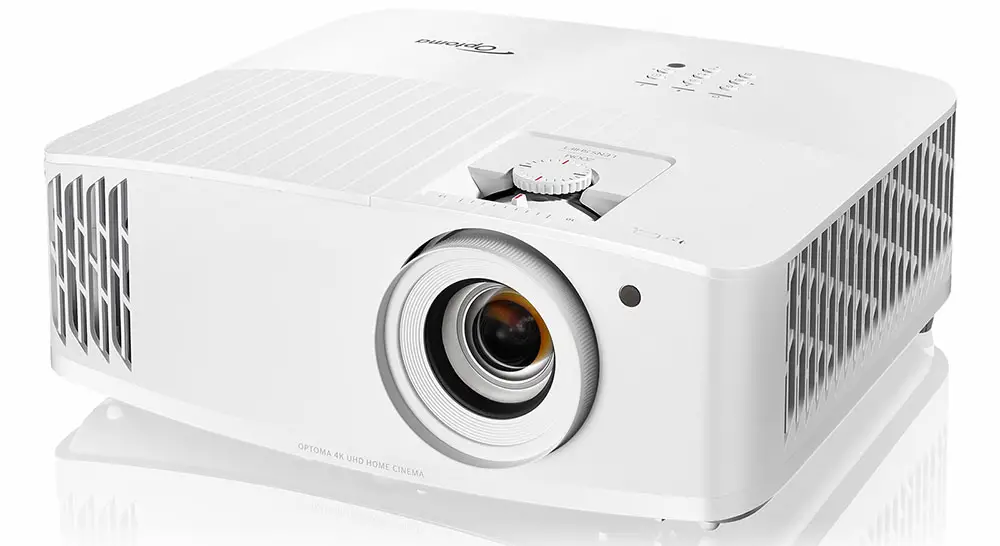
Ventilation looks pretty good as the whole right side, as we look the projector from the front, is being used to let cold air in while on the left front corner there is where the hot air comes out. In general a pretty standard cooling solution that keeps the projector at normal temperatures.
Now at the top side, exactly above the lens, we find the controls for the zoom and lens shift. The lens shift dial allows for a maximum of 10% vertical offset (with tolerance ±5%) which may not be much as some other projectors offer but even getting this in this price should be considered a plus as many sub-$2,000 projectors lack this function completely. Behind that the zoom lever gives the projector a 1.3x optical zoom along with the 0.8 – 2.0 digital one.
At the top side we also get the built-in controls which feature a pretty standard layout. An array of nine circular buttons is complemented by three LEDs on top indicating various projector functions with the first being the on/standby LED, the second being the lamp condition LED and the third the temperature LED.
The available buttons include a central Enter key that is surrounded by the up, down, left and right keys for menu navigation. The up and down keys also act as the keystone correction buttons while the left button acts as an input source selection and the right as a re-sync key also. Top left is the power button, top right the Info button, bottom left the main menu selector and on the bottom right we find the second IR receiver in case you plan on putting the projector on the ceiling.
At the back we find all the connecting ports grouped together and we will talk about them in the appropriate section below. One interesting fact is that while the projector has an on-board speaker it doesn’t seem to have a visible grille from where the sound comes out. The UHD50X is using three, one at the front and two at the rear, tilt-adjustment feet in case you plan on putting it on a furniture and want some easy and fast placement calibration.
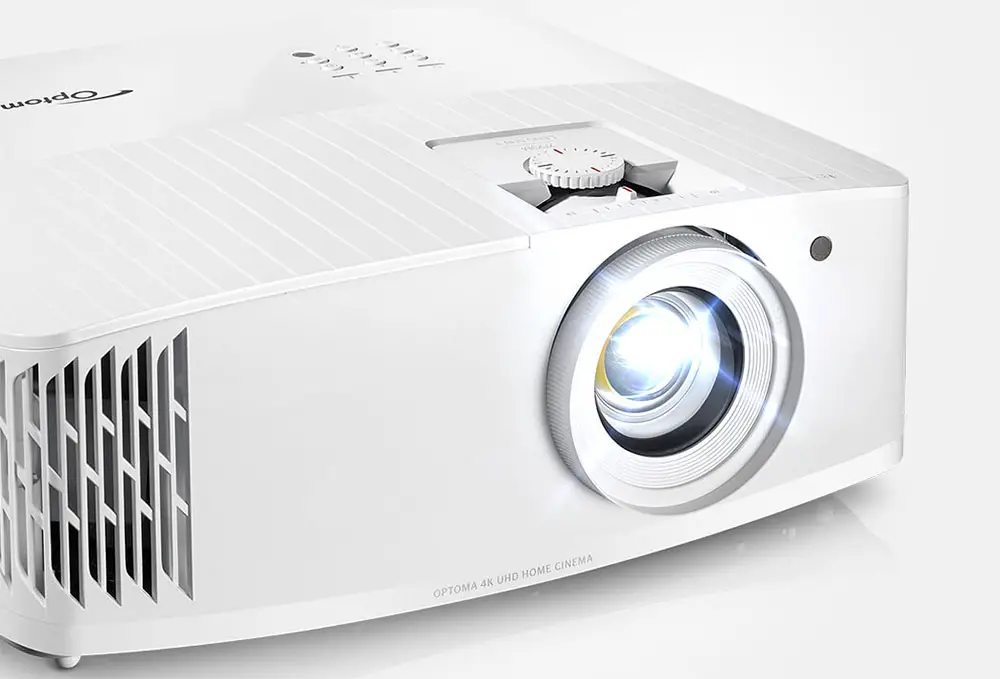
As for the lens that is being used the UHD50X doesn’t offer anything out of the ordinary that its price category dictates. We already mentioned the 1.3 optical zoom and 10% vertical lens shifting that offers the UHD50X some flexibility while it has a throw ratio of 1.21 – 1.59 (with tolerance ±3%) with a projection distance of 4’ – 34.8’ (without zoom) for a 34.1” – 302.4 image size.
Optoma has officially rated the UHD50X noise levels at 26 dB and while this is not mentioned by Optoma this noise usually refers to its Eco mode. If Bright mode is used this usually can reach the 30s or even higher depending on ambient temperature also. Noise is usually comes from two sources in these projectors. The cooling solution and the 4K pixel shifting technology. That’s why usually these projectors are slightly louder than native 4K ones.
It’s not very bothering but if you are very noise sensitive you may want to try them out first because the UHD50X may be slightly audible when in silence as a low pitched sound can be heard. During our testing we could hear the projector in most cases but it was not so loud to bother us very much. But definitely this is a personal matter so keep this in mind.
When it comes to the projector’s lamp life we don’t find anything out of the ordinary also. A 240 watts lamp is being used that can give up to 4,000 hours in Bright mode which extends to 10,000 hours in Eco mode and even can go as high as 14,000 hours in Dynamic mode.
Lastly we should mention about the included remote which seems to be exactly the same that we saw in our UHD50 and UHD60 reviews. Its design, unlike most simple remotes, is more practical as it gets thinner in the middle for easier grip while its buttons are big enough and have a nice rubber feel to them making them easily distinguishable. The biggest advantage of the remote is obviously its backlight function which is very useful if you tend to use it in a complete dark environment.
As for it’s functions it has buttons for all the basic features that you can use like brightness, contrast, keystone correction, input selection, user and image modes among others while for the most advanced settings you will have to use the projector’s main menu. Overall it’s one of the better remotes we have seen in this category and we like that Optoma continues to use it among their new releases.

Closing we can admit that we were pleasantly surprised by the UHD50X. When you are talking about a gaming projector there are certain things you expect from it and this one is one of the most compact 4K gaming projectors we have seen till now. Build quality is good, size is excellent for taking it to a friend for some gaming sessions and the remote is one of the better ones in this price.
Video Quality
Technology used
In terms of the technology that powers the UHD50X things are not much different from the Optoma UHD52ALV that we had recently reviewed. This means that under the hood we find a single 0.47″ 4K UHD DMD DLP chip from Texas Instruments that is responsible for displacing a full HD 1080p image in four different positions at very high speeds in order to produce the full 4K image that is very close in clarity and quality to a native 4K image.
For those not in the loop pixel shifting was created by manufacturers in order to bring down the cost of 4K projectors by offering similar quality at sub-$2,000 levels. Nowadays we have 4K pixel shifters that are even close to the $1,000 limit so compared to a $5,000 native 4K projector the price difference is huge. These pixel shifting projectors are usually distinguished in two different categories depending the type of pixel shifting technology used. There are projectors that shift the image only in two positions and these use slightly larger chips and are a bit more expensive while those that use the 1920 x 1080 x 4 technology tend to be cheaper without any meaningful loss of quality.
But Optoma has not only relied upon this technology in order to get the best out of their units and as such we also find their own UltraDetail technology. Complex algorithms detect each frame and improve image sharpness before the frame is projected. This technology ensures all the information contained in an image is accurately reproduced on the screen to give the best possible 4K outcome. We will talk about this technology in more detail below.
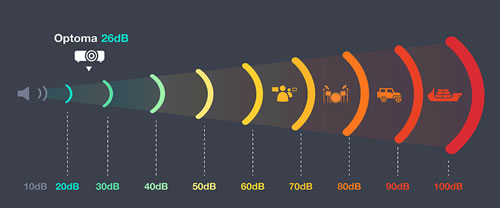
In general if you are considering a 4K projector but you are unsure about going for a pixel shifting unit we would say that its main strength is offering very close quality to a native 4K model but at a fraction of the cost. So if you are worried about your budget a pixel shifter is ideal and you get a lot of value for money. If there is one weakness these type of projectors have is that due to the high speed of the shifting technology noise is always higher than native 4K projectors so it’s always advisable to make a test hearing by yourself to determine if it bothers you or not.
4K UHD / HDR Content
For our 4K HDR testing the film we like to test mostly is no other than Aquaman in its 4K UHD format as it is a particularly bright and colorful film and is ideal for checking any projector capabilities. Now although we haven’t done a direct comparison it seems that the UHD50X has many similarities to the UHD52ALV we had seen before. We have seen this question pop up a lot and many are wondering which of the two is better as their specs are fairly similar. We will comment on that towards the end of our review.
As for the UHD50X specifically the projector has a lot going for it in terms of picture quality and overall performance. First of all lets get the obvious out of the way. Image clarity and sharpness were excellent and we were kind of expecting this as we are used to see these low priced DLP projectors offering amazing image clarity even if they are not true 4K units. Everything from textures, skin imperfections and surfaces composition is easily distinguishable and couldn’t be much better really.
And while image sharpness was very impressive the projectors ability for brightness output was rather good. It may have not been the brightest projector we have seen but for its category it stacked pretty high. Obviously the UHD50X was designed from the ground up to be a gaming projector and not so much as a home theater one but from what we saw the UHD50X can be used for movies in a fairly lit environment without much trouble also. Closing the lights would benefit it even more and many of the underwater scenes in Aquaman showed very good highlights making this one a very flexible offering from Optoma.
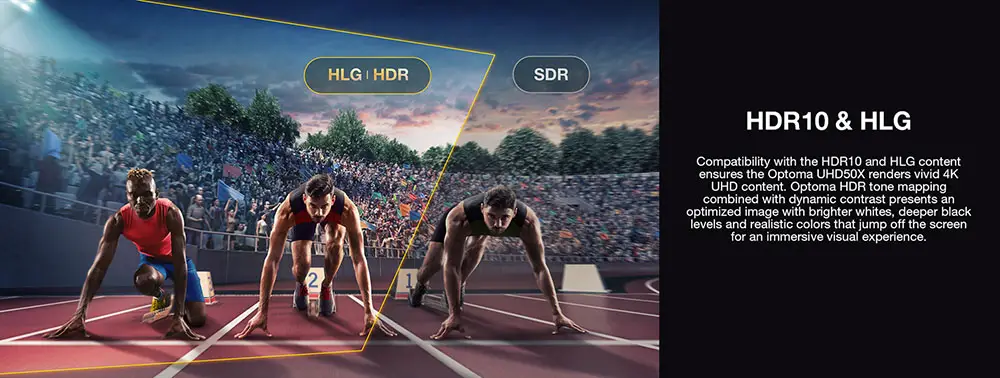
In terms of contrast ratio Optoma is rating the UHD50X at 500,000:1 with Dynamic Black enabled. Dynamic Black is Optomas feature that works like an auto iris but obviously it has certain disadvantages compared to a real one. Dynamic black cannot make quick changes to the light output and the end result is not as obvious as an iris can do. All these low cost projectors suffer from mediocre black levels so having this Dynamic Black mode certainly helps a lot this projector to somewhat improve its weakness.
When you are watching HDR content the projector will switch to the appropriate HDR display mode and from there you can decide which HDR picture mode you like the most. Optoma offers four different modes with Detail, Film, Standard and Bright the ones available. From what we saw we would choose probably the Standard setting but if you find the image too dark you can go for the Bright mode instead.
Lastly we should mention about the projectors HDR protocols support which is pretty standard among most projectors nowadays either cheap or expensive. As such we get the HDR10 which is the basis for 4K UHD playback along with HLG which is used for broadcasting. No Dolby Vision or HDR10+ here but with most projectors having limited brightness capabilities there is not much to be missed by these two.
Full HD / SDR / 3D Content
While 4K is the hot topic nowadays we shouldn’t forget the vast library of Full HD content still being available as a huge number of films haven’t made the transition to 4K yet. So any 4K projector should also be able to upscale lower resolution content to 4K with good results and for this reason we tried out the Blu-ray version of Oblivion.
Image resolution and details were very good as you could see many details on various fabrics and characters clothes. Colors were also pretty spot on even without any major calibration needed which makes this one an excellent out-of-the-box performer. Now blacks even though not as impressive as some more expensive models they could be described adequate, especially with the Dynamic Black turned on.
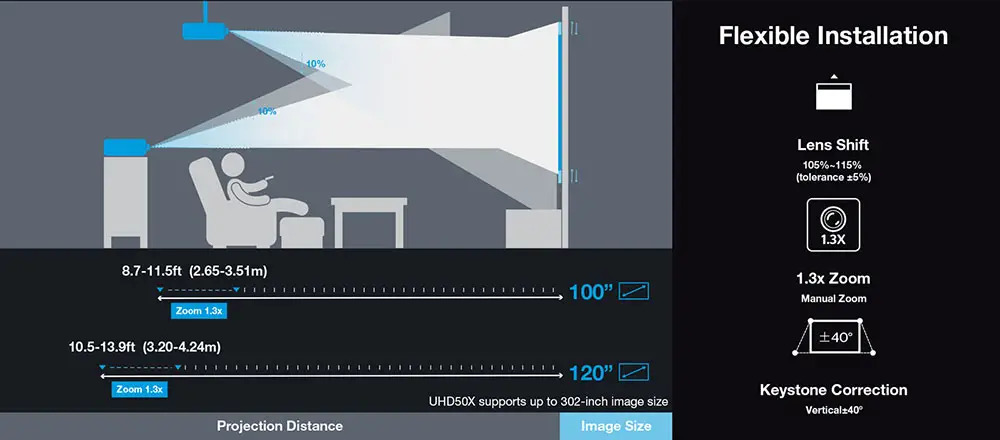
We did try out the UltraDetail and BrilliantColor features that Optoma offers and we could say that for UltraDetail we would keep it to a minimum level or turn it off completely as it can introduce undesired noise to the image. As for BrilliantColor we would recommend a medium setting as higher values are mostly suited only for rooms that have excessive light.
Generally we would say that the UHD50X fared pretty good in our tests while showing the same weaknesses we have seen in most low cost 4K DLP projectors and this is no other than the average black levels it can output. For casual users and those that are not particularly demanding will find the black level performance good enough but if you are particularly picky then you will have to check a more expensive category to get any significant upgrade on this area.
Lastly we should not forget to mention that the projector also supports 3D. This may be a dead format for TVs but it has certainly found its home with projectors. The UHD50X has no problem with 3D content and when the appropriate signal is detected the projector will switch automatically to the 3D mode. We didn’t observe any major artifacts or crosstalk but brightness, as with all 3D content, takes a major hit. To view 3D content you will need to use DLP Link active shutter 3D glasses that unfortunately are not included with the projector.
Color Coverage
In terms of color performance the UHD50X is using a similar 8-segment color wheel that we had seen in the UHD52ALV with two sets of red, green, blue, and white segments. There is no extra wide color filter included here as this we usually find in more expensive models but the projector with its RGBWRGBW color wheel still manages to support wide color gamut.
As we usually do, we will talk in more detail about the available color modes in our next section of the review but in terms of color performance and accuracy we would suggest you to use the Cinema mode as this gave us the best results in terms of contrast, color gradients and realistic color volume without the need for any calibration.
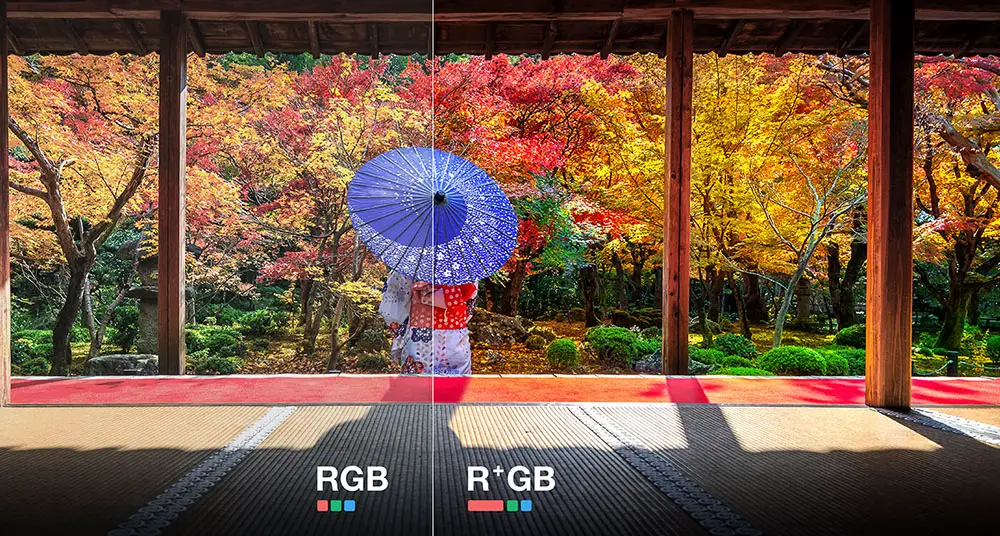
We always favor projectors that manage to offer image quality and colors that are pretty accurate without the need to fiddle deeper into its menu. And while there will always be those that want to tweak every last bit of their projector many casual users want to spend as little time as possible in order to get the best out of it. And this projector seems to be ideal for such a target audience.
One last thing to mention here is that as with all projectors that use color wheels there is a chance that you will be prone to see a rainbow effect which can be bothering to some. Not all people can see it and certainly it was not something we saw but some small percentage can see it and can be really bothering so make sure you are not prone to this or at least make sure you make a test run before purchasing in order to determine if it is a problem in your case or not.
Brightness / Picture Settings
Next is our brightness tests and while the UHD50X is rated as a 3,400 lumens projector we are curious to see how close to this number we can actually get as these theoretical numbers are in reality only marketing material and almost never live up to be real ones. And with the limited brightness capabilities projectors have in general there is a huge debate on how effective HDR brightness is as they cannot even come close to what TVs can produce nowadays..
Keep in mind that there are many factors that can affect brightness on a projector so the numbers we give are only for giving you a general idea of the projector’s capabilities and yours may differ in the end. When watching SDR content the available modes include Bright, Cinema, HDR SIM, Game, Reference and a User defined. The other modes like 3D, HDR and HLG are used automatically if the appropriate signal is detected.

As always we use the widest angle along with Bright mode in order to get the maximum brightness and in this case we got 2,805 lumens. And while this may be the most bright it certainly is not the most accurate as it was slightly on the green side as it happens with the brightest mode. Cinema came in second with 1,305 lumens but had much more accurate colors to begin with while Game and HDR SIM were pretty close at 1,110 and 1,070 lumens respectively. Reference came in last with 600 lumens of brightness.
For HDR mode we got 1,412 lumens which is not bad either but you don’t have much choice there as the HDR mode is engaged the moment it detects an HDR signal. As for SDR content we would recommend the Cinema mode as it came with the best out-of-the-box performance in terms of color reproduction.
Black Levels / Contrast
We have seen time and time again all these low cost 4K pixel shifters to have less than stellar black level performance and the UHD50X is no different. You will have to go to a more expensive category in order to find a projector that can give you deeper blacks than what we usually find here. But things are not so bad as it may sound. Yes, blacks may not be as deep as some more demanding users would like them to be but they can still be considered stellar.
And the UHD50X has a certain advantage. Keep in mind that in a dark environment if a projector cannot display very deep blacks it will be much more evident than in a well lit room. The more light you add to the room the less this weakness will show. And since the UHD50X is advertised as a gaming projector it means that more than certainly you will have some ambient light in the room when in use so while the problem is still there it wont be so much visible.
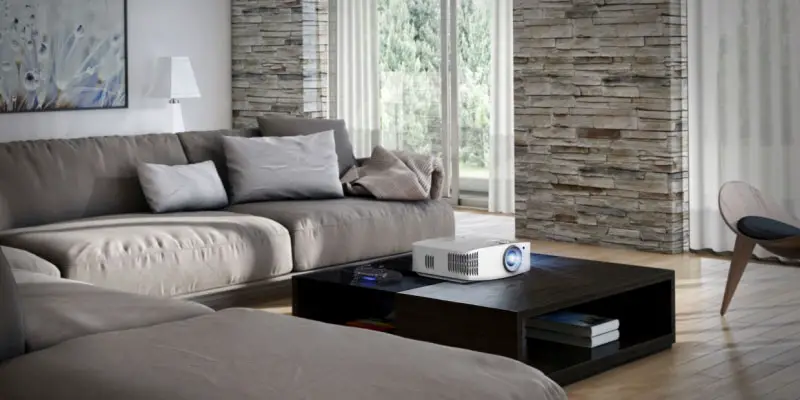
Also while the projector is missing a true dynamic iris the available dynamic black mode can help a little with black levels and can certainly improve the image in a completely dark environment. With the Dynamic black mode enabled Optoma claims a 500,000:1 contrast ratio but one thing that we did noticed was that while using it the fan of the projector would change speed depending on the how bright the lamp was. And with the projector being already a bit too loud this change of speed may distract some from the experience. It’s not a huge problem, but one that should definitely be mentioned.
No surprises to be honest here. These cheap 4K DLP pixel shifting projectors always had problems with deep black levels and the UHD50X follows the same pattern. For someone that is not nitpicking you will find the blacks just fine, just don’t have extreme expectations in this price range.
Input Lag
With the UHD50X being a true gaming projector the input lag seems to be the most interesting part of our review (along with motion performance that comes next) since this section will interest most of those looking at getting such a unit for their gaming pleasure. Now there are a few things worth mentioning here and the first one is that while the projector is being advertised as having very low input lag this still is much higher than what even low tier TVs can do nowadays.
We have seen even the cheapest TVs from the big manufacturers offer as low as single digits input lag something that is impossible even for a true gaming projector. But in general we tend to agree that anything under the 30ms mark can be considered very good for any projector that is intended for gaming.
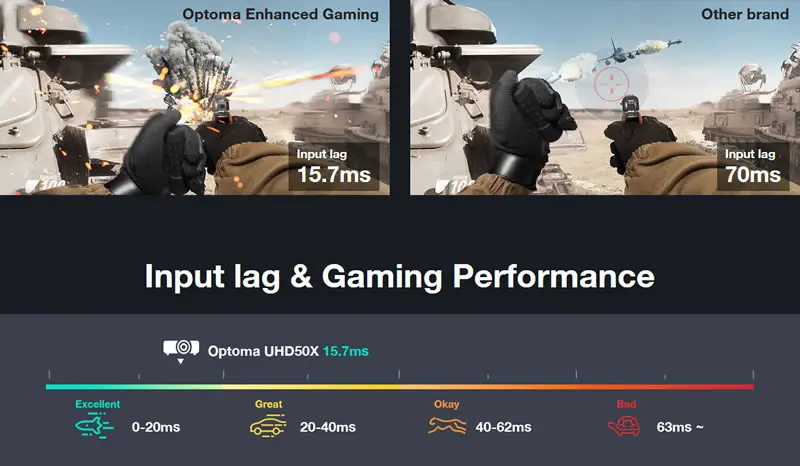
And the UHD50X is one of these rare cases that the manufacturer provides actual numbers regarding its input lag and from what they have publicly released they claim that the projector can go as low as 15.7ms in 1080p@240Hz with Enhanced Gaming mode enabled. The highest number seems to be at 4K@60Hz with a still respectable 25.8ms.
Now according to our measurements we were able to get an input lag of 24.5ms at 1080p@60Hz which is pretty close to what Optoma claims. In 4K resolution at 60Hz input lag was slightly higher at 26.5ms which is still very good and indeed very close to Optoma’s numbers. We were not able to test all refresh rates that Optoma has provided but the numbers we saw indicate that what Optoma claims is true and for the other resolutions and refresh rates.
But to all the above there is a catch. And a pretty big as it turned out. It seems that when you have a 4K signal and you turn Game mode on the projector is turning off it’s XPR pixel shifting technology in order to achieve this low input lag. This means that the resulting image you get is actually in 1080p resolution instead of 4K. Optoma is wrongfully not clear about this as in all their promotional material they clearly show that you can get these low numbers in 4K@60Hz but unfortunately this is only for the input signal. They should clearly state that the output is different and of lower quality.
Another thing to mention here is that we are a bit disappointed that such a gaming projector is missing any kind of Variable Refresh Rate (VRR) technology either it be AMDs FreeSync or NVIDIA’s G-Sync which could greatly benefit the next generation of consoles to alleviate any possible screen tearing.
Now before we close this section, as we always tend to do, we connected our PS4 and went for a few laps with F1 2019 just to get a feel of how the projector’s low input lag translates to a real world situation. The Ps4 console caps at 1080p@60Hz and in this resolution we got 24.7ms which was well within the theoretical specs. The UHD50X performed admirably in this regard. All commands registered very fast and we had no problems with delays or slow response time. Everything was great and show how good work Optoma did with this one.
Motion Performance
Motion performance is the number one feature that is highly advertised for the UHD50X as according to Optoma this is the first 240Hz gaming projector. But as it always happens when marketing material is involved this 240Hz refresh rate tells only half the truth.
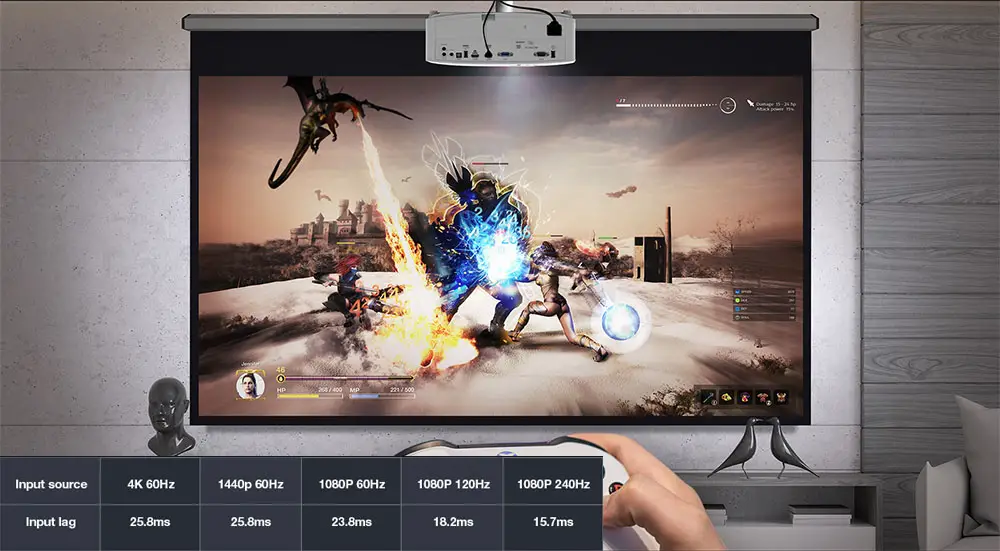
First of all this high refresh rate can only be used with PCs as no current gaming consoles or the ones that are about to be released can support such a high number. The PS4 and Xbox One X have certain limitations due to the HDMI 2.0 ports they use. As such the PS4 can do 1080p@60Hz while the Xbox One X can go as high as 1080p@120Hz. The new PS5 and Xbox Series X will be able to go as high as 4K@120Hz which is cool but there is a problem. The UHD50X cannot do such a high refresh rate in 4K resolution, only in 1080p.
So to make things slightly clearer the UHD50X projector can do a maximum of 60Hz refresh rate in 4K or it can do 60Hz, 120Hz or 240Hz in 1080p resolution. While for many this may seem a little awkward it basically is the limitations of the HDMI ports that Optoma decided to go with in the UHD50X that do not allow for anything better.
But while the UHD50X may not be the definite gaming projector for the next generation of consoles it definitely is a glimpse of where things tend to go. Will there be a projector with HDMI 2.1 that will be capable at supporting the high refresh rates of the PS5 and Xbox Series X in 4K resolution? You bet. But technology always go forward and there will always be something better coming down the line. The UHD50X is available right here, right now and for those looking for one to feed their gaming needs the UHD50X can offer excellent results with regard to its motion performance.
Ports & Connectivity
Usually when approaching the lower end of the pricing ladder we tend to get less and less connectivity options. This is one area where Optoma seems to be pretty consistent among their budget models and the UHD50X seems to be no different. Looking at the back of the projector we will mention everything from left to right.
First there is a USB Type-A that is only being used for service, an RS-232 port, a VGA input, two HDMI inputs, a USB power output connector, a S/PDIF connector, a 12V trigger for motorized screens and two analogue 3.5mm connectors, one input and one output.
Now we need to mention a few things here and first of all about the HDMI inputs. The one on the left is a HDMI 2.0 which can support up to 4K@60Hz while the one on the right is an older 1.4 that can go up to 4K@30Hz. We already mentioned above about the limitations of the projector’s acclaimed 240Hz refresh rate and we should also mention that there is no HDMI 2.1 here that would be perfect for the new generation of gaming consoles. Also one more thing to notice is that the USB port can only be used to power other devices like a HDMI dongle as the projector lacks any kind of internal media player.
If there is one thing that is a bit disappointing is the limitation of the HDMI 2.0 ports. Advertising this as a gaming projector and with the release of the new gaming consoles it would be perfect if it would be able to fully support them but unfortunately as it cannot do 4K@120Hz it means that you will have to sacrifice resolution in order to get the high refresh rate the projector can do for next generation consoles.
OS, Apps and Features
Last part of our review includes the user interfaces and any extra features the projector may include. Now unlike the previously reviewed UHD52ALV which was marketed as a smart projector and it used a user interface that looked more closely to a smart TV the UHD50X is more simple as Optoma has included only the most basic of functions. Don’t forget that this is designed as a gaming projector so there was no need to add any unnecessary smart features or functionality.
The main menu is separated in various categories depending on the purpose of each one and as such we find four main tabs in the left of the screen with Display, Audio, Setup and Info. In the Display tab you will find all the available settings and menus that has to do with image calibration like brightness, colors, contrast, aspect ratio, picture modes, display modes along with the various image technologies that Optoma has included like BrilliantColor, UltraDetail, Dynamic Black mode and obviously the Enhanced Gaming mode which is the highlight of this projector.
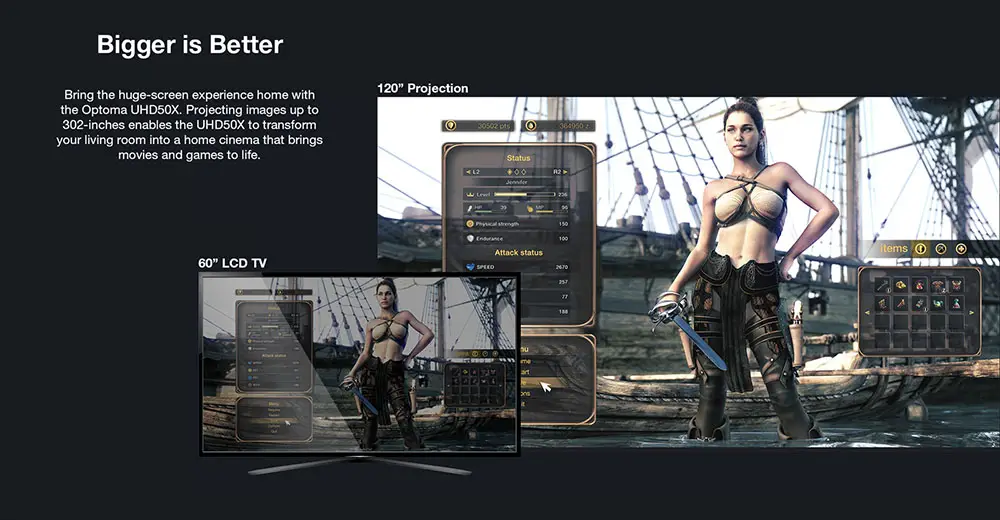
The Audio tab include some very basic audio settings like volume, mute and turning on/off the internal speaker, the setup tab includes options for projection placement, lamp options, power settings and maintenance while the Info tab does what it says. It display various information on the projector like general projector information, resolution, color settings and display modes.
In general what we get is a very basic menu without any fancy visuals. It gets the job just fine but we live in an era where visuals are of great importance and we would like to see projector manufacturers offer something better than just menus that look like they belong in an 80s home computer.
The projector is stripped of any extra features and focuses entirely on offering plenty of options that has to do with image calibration. As such Optoma’s UltraDetail and BrilliantColor technologies are available along with Dynamic Black mode. Although the UHD50X comes with many more settings and image features these three that we mentioned here are the most highlighted ones from Optoma.
One last thing that is worth mentioning is the on-board sound. It wouldn’t be a serious gaming projector if it didn’t have on-board sound and Optoma did include a speaker for this reason. Now while many portable projectors usually go for a stereo setup the UHD50X is only featuring a single 5 watts speaker so don’t expect anything extraordinary out of it. In fact we found the sound to be a bit on the weak side and a stereo audio setup would definitely help. Don’t get your hopes up for the on board audio, it can give you the basics, but just barely.
Not much to say here. The UHD50X is very light on extras and it was pretty obvious that Optoma went all in with their image features and left everything else out. Obviously the more the better but as this is clearly a gaming projector not much else was deemed necessary.
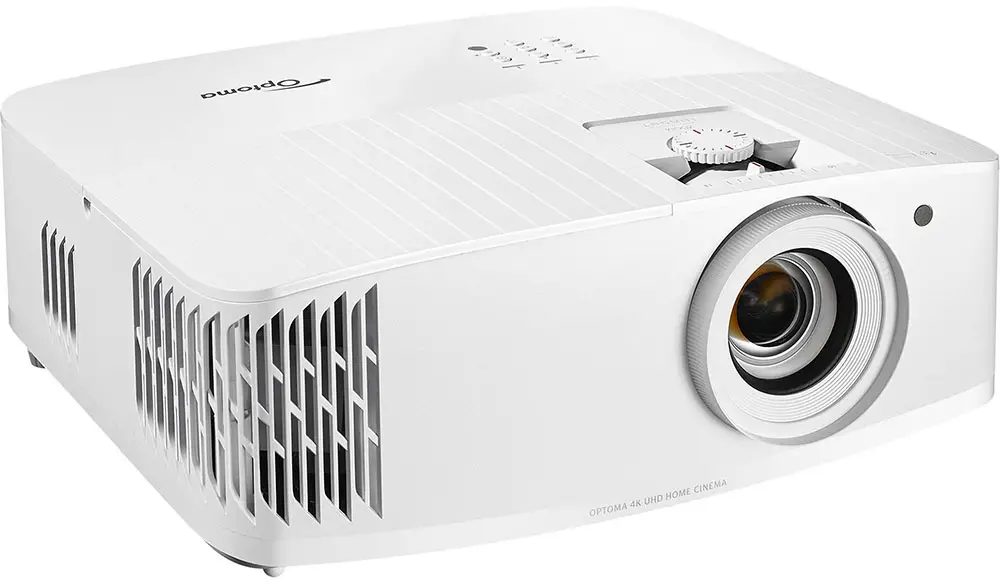
Final Thoughts
Over the past couple of years we have reviewed many of these low budget, sub-$2,000 4K projectors that use pixel shifting technology and all of them exhibit more or less the same strengths and weaknesses. But it is the first time that we find a similar projector but instead of focusing in offering many extras or smart functionality it was designed to act as an all out gaming projector with a 240Hz refresh rate that is a first in this category.
The UHD50X has many good things to talk about. Build quality was good enough and we were particularly fond of the backlit remote it came with. Its 4K images were sharp and with extreme clarity while its out of the box color performance was extremely good and will please many casual users. Its low input lag and high refresh rate will make happy even the most demanding of gamers and with a price close to $1,500 this can be considered as an amazing all around projector that can be used for movies and gaming at the same time.
On the downsides its HDR performance was average and we couldn’t say that it made HDR content to pop as it should. Also black levels were mediocre but this is not a problem of this particular projector and all units in this price have the same characteristic. You will have to go higher in price to get some good black levels performance so there was no real surprise here. Noise was also a bit higher than what we would like although not overall bothersome and lastly the refresh rate.
Optoma is advertising this as a 240Hz projector but this is half the truth as this applies only to 1080p resolution. The projector is missing any HDMI 2.1 ports so it cannot do both 4K and high refresh rate and for this we will probably have to wait for the next wave of gaming projectors that will come with HDMI 2.1 ports.
Closing our review one question many users seem to have is whether to go for the UHD50X or the UHD52ALV as both of them feature very similar specifications. What we can tell you is that if using it for movies is your main thing the UHD52ALV is the better choice. But for mixed use or if you are serious about your gaming the Optoma UHD50X is the only way to go. Optoma has created a nice gaming projector that is obviously not perfect but has many nice qualities and will please those that will chose this for their gaming pleasure.
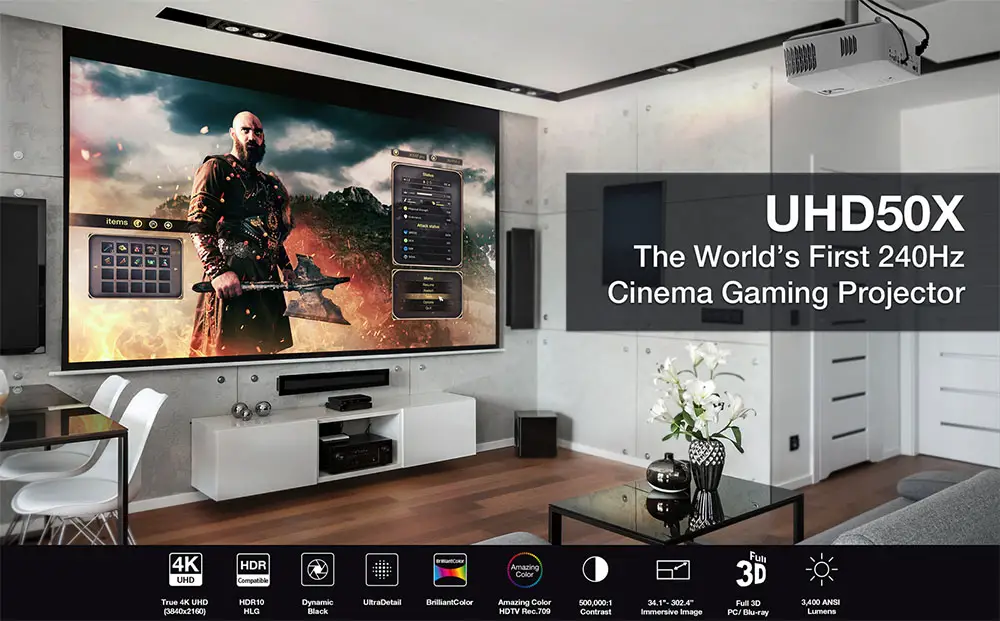
For more reviews you can check our dedicated 4K Projector reviews list or even look at our Product Reviews Table where you can find the brand and specific product you are looking for.
Cheapest Places to Buy :
*We are a reader-supported website. When you buy through links on our site, we may earn a small affiliate commission at no extra cost to you. Home Media Entertainment does not accept money for reviews.*
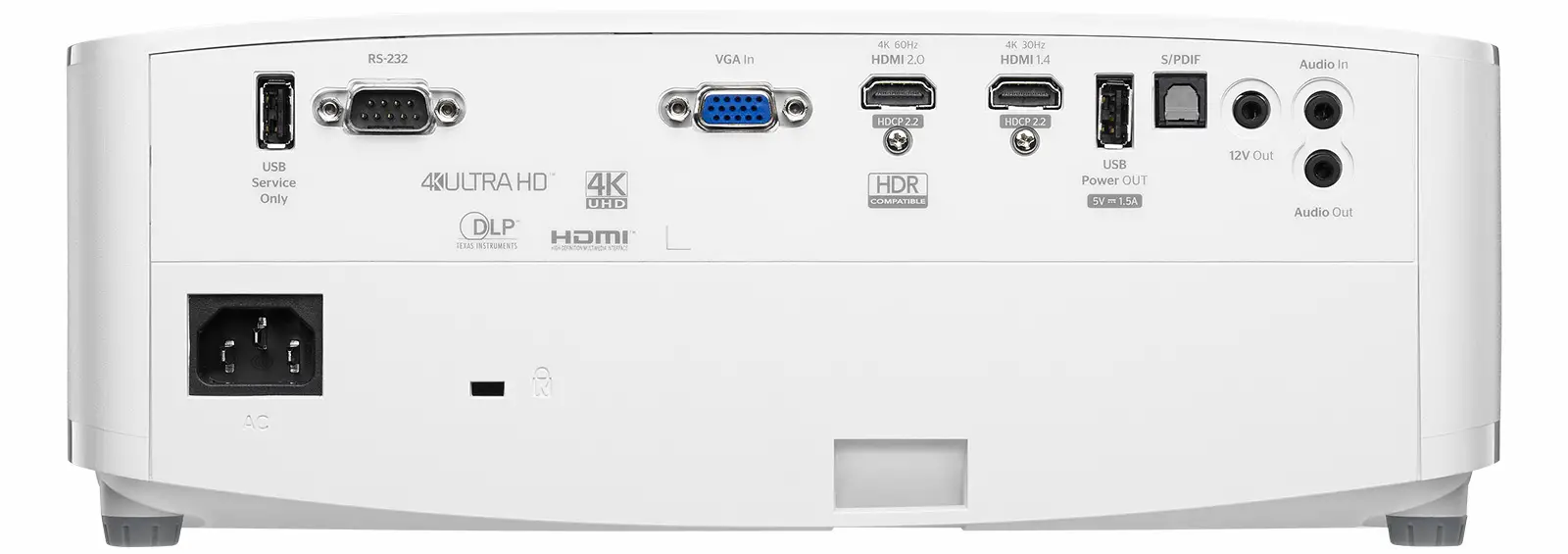
I have a projector for 5 years now but I was looking into changing it to a new one that would also be good for gaming as well as for movies. I had a couple in mind but never considered the UHD50X. Your review has seriously made me consider it now.
The UHD50X is an excellent choice for mixed use. And with such a low price you cannot go wrong with it.
I really appreciate your efforts in putting together this extremely detailed review. I am not much into technicalities so it was great for me to read your article and actually understand everything. You have a way of writing simple and not going into a lot of numbers. As for the projector this will be my first so I am not much into them and I want to get something that will be worth its money. I am going to use it for both movies and games so do you believe this is the best choice for me?
For mixed use the UHD50X is great. And since this is your first projector you will find its quality very good. You cannot go wrong with it.
I like playing video games with my nephews and our Tv is getting a little too small for us to enjoy our games comfortably. So, I was thinking to get a gaming projector. And I think the Optoma UHD50X is a real fit.
And I think the review you wrote was exactly what I needed, with all the needed details to have me thinking. I like the brightness and overall gaming focus it has. I seriously will consider this one.
Thanks
You are welcome. Let me know if you need any more help.
This is exactly the kind of review I was looking for. I was torn between the UHD50X and the UHD52ALV but they seemed very close in specs and I didn’t know which would be better. Thanks for clearing this up. Great review you wrote there! Keep up the good work.
If you are more into gaming then the UHD50X is better. For movies better go for the UHD52ALV.
Hi, I come from an Epson eh tw7300, which I keep in a living room / living room, I was intension to take the tw9400, but I don’t know if for the mixed use I do, for the obviously not dedicated room and also having a little girl more correct to save and take this Optoma, comq I think that from the tw7300, it is an upgrade anyway, especially in sharpness, right? Thanks
Everything depends on your budget really. The 9400 is obviously the better projector here almost across the board but is also the more expensive one. Are you able to give the given price? To be honest if I were you I wouldn’t change the 7300 with the UHD50X. I would prefer to pay the extra amount and get a projector where I could get a noticeable jump in quality if possible. Otherwise I would stay with the 7300 which is a damn fine projector.
The fact is that I have already sold the 7300, and given that Epson will probably come up with the successor of the 9400 within a year, then I was thinking of taking the UHD 42 in the meantime, spending temporarily less, to be ready to buy the new Epson that as I said before, I think will arrive by next year 2021.
Well then you don’t have much of a choice. If you can afford to spend on a cheaper solution and then go for the new Epson that will come out then go for it.
Just for the shake of our conversation along with the UHD50X I can also suggest you the BenQ HT3550/W2700 (I don’t know in which region you live). It is similarly priced with the Optoma and equally good. It has a bit higher input lag but not to the point of being bothering.
I am considering getting this projector. Just cannot really make up my mind. What other projectors are in the price range? I am looking for a 4k and 3D capable projector. It will be used mostly for PC gaming with an average time watch movies/series
Hello Rashin. Well, in this price range there are a couple more options but if you plan on using it mostly for gaming then the UHD50X is the only way to go to be honest. Not that other projectors are not good for gaming but if you want the absolute lowest input lag then there are not many options to consider. The UHD50X is good enough and surely is a nice projector to use for your average movie viewing.
A person on Amazon made a review that stated:
Cons:
– !!!!! Enhanced Gaming Mode (EGM) is downscaling 4K input signals to 1080p !!!!!
Optoma has refused to acknowledge this issue, or clarify if it can even be resolved through a firmware update. The current consensus from UHD30/50X owners is that Optoma incorrectly measured latency on the EGM ‘4K’ signals (actually 1080p) during production and accidentally misrepresented the projectors capabilities in their marketing.
This means that is may be physically impossible for this projector to output 4K @ 25ms. If you are intending to use this projector for the upcoming Xbox Series X / Playstation 5 — please do not purchase this projector.
For more information, you can also see Adam W’s review here on Amazon and some of the other discussion happening online (avsforum, reddit, …)
> Is this true? Your opinion would be helpful. Thanks
Hello Chris. It seems that this holds truth. It seems that the hardware is not capable at outputting such low input lag with the XPR pixel shifting technology enabled that produces the 4K images. As a result the pixel shifting is turned off when EGM is turned on and you get a standard 1080p resolution image in order to achieve this low input lag. The wrong with Optoma is that they clearly say that you achieve this low input lag at 4K. They should at least mention that when EGM is enabled resolution is limited to 1080p even with a 4K input signal.
Do you know what the input lag is like gaming in 4k with EGM turned off? Would be below 40ms?
Hello Daniel. With EGM off input lag will hover around the 50ms mark.
Thank you for this very in-depth review. I have a couple questions at the bottom but I wanted to explain where I’m coming from. I currently own an old Viewsonic PJD7280HD from around 2013, and it’s served me well enough. I just got a PS5, and given the age of the projector, I was thinking about upgrading to 4K. And I was also hoping for a projector that doesn’t get as washed out with modest lighting on. The Viewsonic is okay in this regard for bright scenes, but dark scenes are hard to make out. Seeing as how the Viewsonic is a pretty low-budget brand, I was hoping a more modern projector might have slightly better shadow detail with some modest ambient light, although I understand the limitations and that the Optoma UHd50X doesn’t necessarily excel in this area. Nonetheless it seemed like a good choice at least for 4K until I found out about the misrepresented 4K gaming mode and lag time. The thing is, my current Viewsonic projector already has HD with an input lag of less than 20ms. So if in gaming mode the Optoma is actually giving me an HD image, I’m not sure if there’s any point in upgrading for gaming. For movies, sure, there’d be the 4K benefit. On the other hand, I’ve also thought maybe gaming in 4K at 50ms lag would be okay. I play a lot of games, RPGs and platformers mostly, but I’m not a hardcore FPS gamer, although I do play them casually from time to time. Mostly the solo campaigns. I guess my big question is then, do you think I would notice going from sub-20ms to 50ms input lag time? I just really don’t want to be annoyed by input delay. Or maybe I should just wait it out until they’ve got the technology a little more ironed out before going 4K? Do you think that a more modern projector like the UHD50X might have slightly better shadow detail with modest ambient light than an old one like the Viewsonic? Thank you for your time.
Hello Kyle. I understand you completely and the UHD50X has been the main subject of discussion for many that want a projector for gaming.
To be honest there is more to the projector than low input lag. It’s the colors, contrast ratio, black levels, motion performance etc etc. Now as far as the high input lag with Game mode off this is a question only you can answer. What I can tell you is that I am not a hardcore gamer either and I play just fine on my old Samsung TV with game mode off which translates to about 100 ms of input lag. It’s all a matter of getting used to it. But I can speak only for myself and you may not be able to get used to it. Unfortunately I cannot answer that.
Obviously there will be future models that will rectify the problems the UHD50X has but we don’t know when this will be and the UHD50X is here, available now. Also since you play mostly offline rpg games I think input lag doesn’t have such a huge impact on this.
If I was you, and this is completely based on my experience and my expectations I would go for it. This is the best answer I can give you. It’s not a clear one but as every person has different expectations I cannot tell you what is best for you.